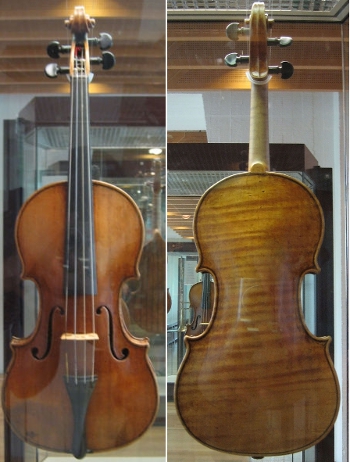 |
| January 11, 2022 | Volume 18 Issue 02 |
Designfax weekly eMagazine
Archives
Partners
Manufacturing Center
Product Spotlight
Modern Applications News
Metalworking Ideas For
Today's Job Shops
Tooling and Production
Strategies for large
metalworking plants
Secret of Stradivarius violin sound solved? Surprising finding
By Keith Randall, Texas A&M University
New research co-authored by a Texas A&M University scientist has confirmed that renowned violin maker Antonio Stradivari and others treated their instruments with various chemicals that produced their unique sound, and several of these chemicals have been identified for the first time.

Antonio Stradivari violin of 1703 on exhibit, behind glass, at the Musikinstrumentenmuseum (Berlin Musical Instrument Museum), 2006. [Photo credit: Wikipedia By Husky, CC BY-SA 3.0 https://commons.wikimedia.org/wiki/File:Stradivarius_violin_front.jpg via Wikimedia Commons]
Joseph Nagyvary, professor emeritus of biochemistry at Texas A&M, first proposed the theory that chemicals used in making the violins -- not just the skill of making the instrument itself -- was the reason Stradivari and others, such as Guarneri del Gesu, made instruments whose sound has not been equaled in over 200 years. An international team led by Hwan-Ching Tai, professor of chemistry at National Taiwan University, has had these findings published in Angewandte Chemie, the leading journal of chemistry in Germany.
About 40 years ago at Texas A&M, Nagyvary was the first to prove a theory that he had spent years researching: that a primary reason for the pristine sound, beyond the fine craftsmanship, was the chemicals Stradivari and others used to treat their instruments due to a worm infestation at the time.
"All of my research over many years has been based on the assumption that the wood of the great masters underwent an aggressive chemical treatment, and this had a direct role in creating the great sound of the Stradivari and the Guarneri," Nagyvary said.
His findings were verified recently in a review by the American Chemical Society, the world's largest scientific organization.
The current findings of the research team show that borax, zinc, copper, and alum -- along with lime water -- were used to treat the wood used in the instruments.
"Borax has a long history as a preservative, going back to the ancient Egyptians, who used it in mummification and later as an insecticide," Nagyvary said.

Researcher and musician Joseph Nagyvary holds a violin (left) and a viola with poplar wood fingerboards. [Courtesy of Joseph Nagyvary]
"The presence of these chemicals all points to collaboration between the violin makers and the local drugstore and druggist at the time. Both Stradivari and Guarneri would have wanted to treat their violins to prevent worms from eating away the wood, because worm infestations were very widespread at that time."
He said that each violin maker probably used his own home-grown methods when treating the wood.
"This new study reveals that Stradivari and Guarneri had their own individual proprietary method of wood processing, to which they could have attributed a considerable significance," he said. "They could have come to realize that the special salts they used for impregnation of the wood also imparted to it some beneficial mechanical strength and acoustical advantages. These methods were kept secret. There were no patents in those times. How the wood was manipulated with chemicals was impossible to guess by the visual inspection of the finished product."
The new Angewandte Chemie paper states, "The overall purpose [of the chemical treatment] may have been wood preservation or acoustic tuning. Hemicellulose fragmentation and altered cellulose nanostructures are observed in heavily treated Stradivari specimens, which show diminished second-harmonic generation signals. Guarneri's practice of crosslinking wood fibers via aluminum coordination may also affect mechanical and acoustic properties. Our data suggest that old masters undertook materials engineering experiments to produce soundboards with unique properties."
Nagyvary said the varnish recipes were not secret because the varnish itself is not a critical determinant of tone quality. In contrast, the process of how the fresh spruce planks were treated and processed with a variety of water-based chemical treatments is critical for the sound of the finished violin.
Such knowledge was needed to gain a "competitive advantage" over other instrument makers, he said.
Nagyvary added that, in new work, the team found the chemicals used were found all over and inside the wood, not just its surface, and this directly affected the sound quality of the instruments.
Antonio Stradivari (1644-1737) made about 1,200 violins in his lifetime and sold them only to the very rich, including royalty. Today, there are about 600 Stradivarius violins remaining.
A lesser-known contemporary of Stradivari, Guarneri del Gesu, had trouble selling his work, but his instruments are now considered equal in quality and price to Stradivarius violins.
"Their violins have been unmatched in sound and quality for 220 years," Nagyvary said, noting that a Stradivarius violin today can be valued at $10 million, and a Guarneri can be worth even more.
He said that further research is need to clarify other details of how the chemicals and wood produced pristine tonal quality.
"First, one needs several dozens of samples from not only Stradivari and Guarneri, but also from other makers of the Golden Period (1660-1750) of Cremona, Italy," he said. "There will have to be better cooperation between the master restorers of antique musical instruments, the best makers of our time, and the scientists who are performing the experiments often pro bono in their free time."
Nagyvary has been involved with violin research throughout much of his 87 years. He first learned to play in Switzerland on an instrument that once belonged to Albert Einstein.
Published August 2021
Rate this article
View our terms of use and privacy policy
